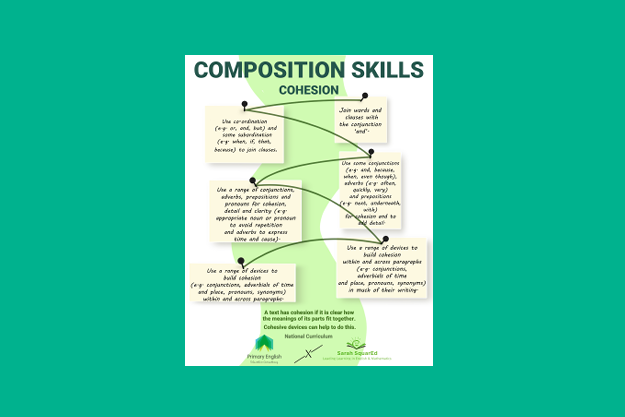Cracking Cohesion
Cohesion is one of those aspects of writing that can be hard to pin down. Two phrases I frequently hear when talking about cohesion with teachers are writing that flows and writing that sticks together. I also regularly encounter the view that it’s easier to spot when writing doesn’t have cohesion rather than when it does – and I certainly know what teachers mean when they say this. But just what is it that gives writing cohesion, and can it even be taught?
In our recently developed Cracking Cohesion training we’ve taken the view that cohesion can be taught. Furthermore, we’re clear that it’s not just something for the top of key stage 2, because we’ve teased out aspects of the national curriculum from year 1 to year 6 that contribute to cohesive writing.
Before we dive into the national curriculum, let’s explore those ideas of flow and sticking together a little more. These are certainly pleasing ways to think about writing as flow suggests movement and fluidity within and across a text and sticking together suggests structure. Personally, I’ve often described this as a golden thread that weaves in and out of the text that appears from place to place as part of the intended pattern. It’s not always immediately apparent that it’s there, but once spotted we can see how it unites the whole. Going back to that idea that cohesion is almost easier to spot when it isn’t present as the writing, when we tug the golden thread out of our weave we create holes, we break the flow of the pattern, and the structure of the cloth is destabilised; just like faltering and disjointed writing that lacks cohesion.
This is all very lyrical, and it makes cohesion sound creative and expressive, which it can be. Cohesion is also incredibly practical and something of an everyday component of creating effective writing. Let’s just take a look at how cohesion is defined in the national curriculum:
“‘A text has cohesion if it is clear how the meanings of its parts fit together. Cohesive devices can help do this’. ”
This definition echoes the views of teachers that cohesion is about the parts of a text fitting together. It also suggests there are tools – cohesive devices – that can be used to ensure texts fit together. And examples of these cohesive devices, it suggests are:
“... determiners and pronouns, which can refer back to earlier words; conjunctions and adverbs, which can make relations between words clear; ellipsis of expected words.”
In our Cracking Cohesion course, we look at each of these and also acknowledge some of the other cohesive devices we can use such as tense, repetition and the use of synonyms.
So, just where is cohesion taught in the national curriculum? Well, it is mentioned explicitly in appendix 2 for years 4, 5, and 6.
Year 4
Appropriate choice of pronoun or noun within and across sentences to aid cohesion and avoid repetition
Year 5
Devices to build cohesion within a paragraph [for example, then, after that, this, firstly]
Linking ideas across paragraphs using adverbials of time [for example, later], place [for example, nearby] and number [for example, secondly]
or tense choices [for example, he had seen her before]
Year 6
Linking ideas across paragraphs using a wider range of cohesive devices: repetition of a word or phrase, grammatical connections [for example, the use of adverbials such as on the other hand, in contrast, or as a consequence], and ellipsis
Once armed with the knowledge that cohesive devices include aspects that join clauses and sentences, such as conjunctions, adverbs and prepositions, we can see that cohesion is implicit in the following objectives found in appendix 2 for years 1 – 3.
Year 1
• Joining words and joining clauses using ‘and’
Year 2
• Subordination (using when, if, that, because) and co-ordination (using or, and, but)
Year 3
• Expressing time, place and cause using conjunctions [for example, when, before, after, while, so, because], adverbs [for example, then, next, soon, therefore], or prepositions [for example, before, after, during, in, because of]
Now, this looks like a lot to digest and is not necessarily as visually accessible as it could be. This is where our Cohesion Roadmap comes in. It’s a clear visual representation of the progression in cohesion built into the national curriculum. You can download it as a PNG file free of charge.
Now, good writing is so much more than the criteria included in the Teacher Assessment Framework for the end of key stage 2 (TAF). But it’s worth noting, cohesion is not an exclusively Greater Depth characteristic. It is included in the TAF criteria for Expected Standard. Creating texts that have cohesion is an aspiration for all of our children, and rightly so in my opinion. We want all of our children to write texts where the component parts fit together.
To book a place on our Cracking Cohesion course, please visit our Eventbrite page or contact us via the Get in Touch tab in the menu bar of this page.

